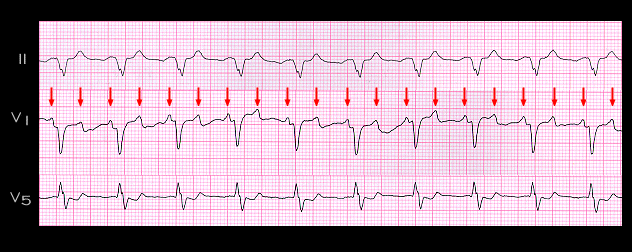
The atrial rate associated with the ectopic atrial tachycardias is usually in the range of 100 to 200 beats per minute. When the rate is more rapid, it may be associated with 2:1 AV block. This is particularly true when the arrhythmia is caused by digitalis because digitalis may cause AV nodal conduction slowing and block as well as inducing the ectopic tachycardia.
The tracing shown here demonstrates an ectopic atrial tachycardia, rate 170, with 2:1 AV block resulting in a ventricular rate of 85. There is also left bundle branch block. It is from a 72 year old patient with congestive heart failure who was receiving digitalis. The P waves are best seen in lead V1 (arrows). There is an obvious P wave before each QRS complex but the second P wave is more difficult to identify because it is superimposed on the T wave.
